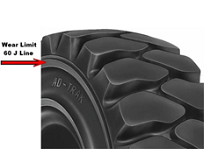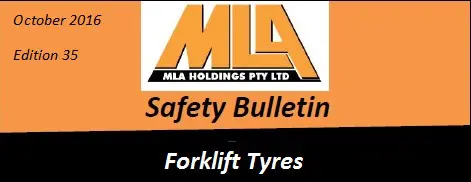

Forklift Tyres is the only part of a forklift truck that is always in contact with the ground. They provide grip for movement, friction for braking and an element of suspension for safety and comfort. The correct tyres in good condition are an essential aid to safe and efficient operations.
Methods of identifying tyre wear out
§ Top of the 60J line
§ The tread depth indicator
o Pneumatic tyres must have a minimum of 1mm of tread over the centre 75% of tread around its complete circumference.
Smooth (Slick) Industrial Tyres
In several applications (Ports & Docks, Waste Transfer, Glass Recycling, Steel Yards etc.) the presence of a tread pattern results in significant tread cutting or damage. At these sites the use of smooth (slick) tyres has led to substantially improved wear rates (lower costs) without any detriment to safety.
Smooth tyres (on paved surfaces) actually have higher levels of grip, even when water is present (up to 15km/hr). The higher grip is a result of the greater contact surface area (tyre to road).
It is incorrect to assume that tyres with no tread are dangerous or provide less traction, on paved (concrete or asphalt) surfaces.Where loose material is present a treaded pattern tyre will result in better grip than a smooth tyre, due to the tread actually engaging the ground surface.
The time to replace forklift tyres varies between types and operating conditions. One of the biggest risks is that tyres are taken for granted, not being inspected as often or thoroughly as needed for safe operation. The checking of all tyres is an important element of a forklift daily or pre-shift check. Tyre condition is also monitored as part of routine preventive maintenance. Action should be taken to replace damaged or worn tyres without delay.
Information from this article was sourced from Bearcat Tyres Pty. Ltd. Call MLA now for an obligation free safety tyre inspection.
Download PDF here








